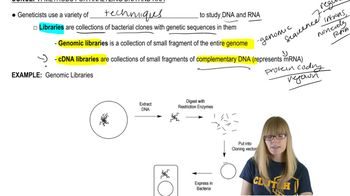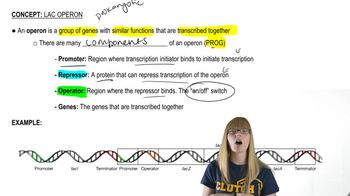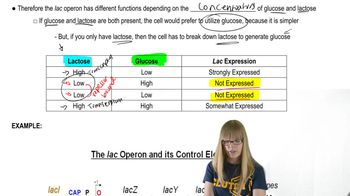Table of contents
- 1. Introduction to Genetics51m
- 2. Mendel's Laws of Inheritance3h 37m
- 3. Extensions to Mendelian Inheritance2h 41m
- 4. Genetic Mapping and Linkage2h 28m
- 5. Genetics of Bacteria and Viruses1h 21m
- 6. Chromosomal Variation1h 48m
- 7. DNA and Chromosome Structure56m
- 8. DNA Replication1h 10m
- 9. Mitosis and Meiosis1h 34m
- 10. Transcription1h 0m
- 11. Translation58m
- 12. Gene Regulation in Prokaryotes1h 19m
- 13. Gene Regulation in Eukaryotes44m
- 14. Genetic Control of Development44m
- 15. Genomes and Genomics1h 50m
- 16. Transposable Elements47m
- 17. Mutation, Repair, and Recombination1h 6m
- 18. Molecular Genetic Tools19m
- 19. Cancer Genetics29m
- 20. Quantitative Genetics1h 26m
- 21. Population Genetics50m
- 22. Evolutionary Genetics29m
12. Gene Regulation in Prokaryotes
Lac Operon
Problem 34d
Textbook Question
Northern blot analysis is performed on cellular mRNA isolated from E. coli. The probe used in the northern blot analysis hybridizes to a portion of the lacY sequence. Below is an example of the gel from northern blot analysis for a wild-type lac⁺ bacterial strain. In this gel, lane 1 is from bacteria grown in a medium containing only glucose (minimal medium). Lane 2 is from bacteria in a medium containing only lactose. Following the style of this diagram, draw the gel appearance for northern blots of the bacteria listed below. In each case, lane 1 is for mRNA isolated after growth in a glucose-containing (minimal) medium, and lane 2 is for mRNA isolated after growth in a lactose-only medium.
lac⁺ bacteria with the genotype I⁻ P⁺ Oᶜ Z⁺ Y⁺
 Verified step by step guidance
Verified step by step guidance1
Understand the role of the lac operon: The lac operon in E. coli is responsible for the metabolism of lactose. It includes genes such as lacZ and lacY, which are involved in lactose utilization.
Identify the genotype components: The genotype I⁻ P⁺ Oᶜ Z⁺ Y⁺ indicates mutations and functional components of the lac operon. I⁻ means the repressor is non-functional, P⁺ indicates a functional promoter, Oᶜ is a constitutive operator mutation, Z⁺ and Y⁺ mean functional lacZ and lacY genes.
Analyze the effect of the Oᶜ mutation: The Oᶜ mutation causes the operon to be constitutively expressed, meaning that the genes are transcribed regardless of the presence of lactose.
Consider the impact of the I⁻ mutation: Since the repressor is non-functional (I⁻), it cannot bind to the operator to inhibit transcription, further ensuring that the operon is always active.
Predict the northern blot results: In both lane 1 (glucose medium) and lane 2 (lactose medium), expect to see mRNA bands for lacY, as the operon is constitutively expressed due to the Oᶜ mutation, regardless of the sugar present.
Recommended similar problem, with video answer:
 Verified Solution
Verified SolutionThis video solution was recommended by our tutors as helpful for the problem above
Video duration:
3mPlay a video:
Was this helpful?
Key Concepts
Here are the essential concepts you must grasp in order to answer the question correctly.
Northern Blotting
Northern blotting is a technique used to detect specific RNA sequences in a sample. It involves the separation of RNA by gel electrophoresis, transfer to a membrane, and hybridization with a labeled probe that binds to the target RNA. This method allows researchers to analyze gene expression by comparing the levels of mRNA in different conditions or treatments.
Recommended video:
Guided course

Methods for Analyzing DNA and RNA
Lac Operon
The lac operon is a set of genes in E. coli that are involved in the metabolism of lactose. It includes genes such as lacZ, lacY, and lacA, which are regulated by the presence of lactose and glucose. The operon is typically off when glucose is present and activated in the presence of lactose, illustrating the concept of gene regulation based on environmental conditions.
Recommended video:
Guided course

Lac Operon Overview
Gene Regulation
Gene regulation refers to the mechanisms that control the expression of genes, determining when and how much of a gene product is made. In the context of the lac operon, the presence of glucose inhibits the expression of genes involved in lactose metabolism, while lactose acts as an inducer, allowing for the transcription of these genes. Understanding these regulatory mechanisms is crucial for interpreting results from experiments like Northern blotting.
Recommended video:
Guided course

Review of Regulation

 4:27m
4:27mWatch next
Master Lac Operon Overview with a bite sized video explanation from Kylia Goodner
Start learning


